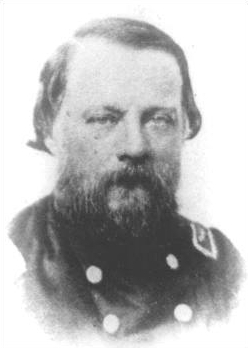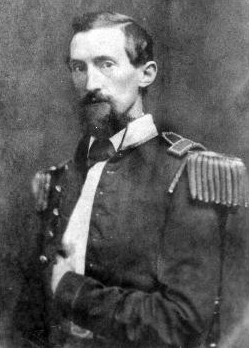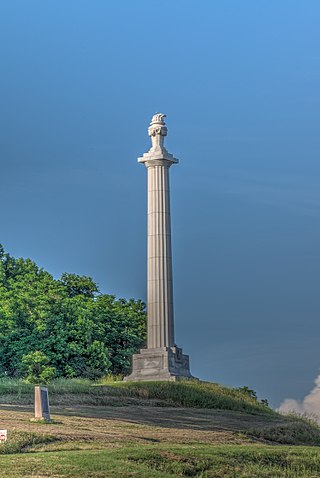The Battle of Plains Store was fought on May 21, 1863, in East Baton Rouge Parish, Louisiana, during the campaign to capture Port Hudson in the American Civil War. Union troops advancing from Baton Rouge, Louisiana, clashed with 600 Confederates at a road junction. The initial Confederate force withdrew, but 400 more Confederates arrived from Port Hudson. Some of the Confederate reinforcement overran Union artillery and routed a Union regiment, but were unable to capture the guns. Union reinforcements advanced to the front, attacked part of the Confederate force and drove them from the field. The Confederates withdrew to Port Hudson, which was almost entirely surrounded by Union troops the next day. Port Hudson was under siege until the defenders surrendered on July 9.

Miles' Legion was a unit of the Confederate Army during the American Civil War. It was commanded by Col. William R. Miles. The unit was officially named the 32nd Louisiana Infantry Regiment but it was never referred to by that name. The legion fought at the Battle of Plains Store and the Siege of Port Hudson. Captured at Port Hudson, the men were paroled, and the legion was declared exchanged in fall 1863. Many of the exchanged men never returned to duty. Those who did return joined Gober's Mounted Infantry Regiment or the 15th Louisiana Sharpshooter Battalion.

The 3rd Louisiana Infantry Regiment was a unit of foot soldiers from Louisiana that fought in the Confederate States Army during the American Civil War. The regiment distinguished itself at Wilson's Creek in 1861. The 3rd Louisiana fought at Pea Ridge, First Corinth, Iuka, and Second Corinth in 1862. The unit defended Vicksburg in 1863 where it was captured. At Vicksburg, the unit's fortification was twice blown up by powerful land mines. The surviving soldiers were paroled and exchanged, after which they performed guard duty for the rest of the war.

The 2nd Louisiana Cavalry Regiment was a unit of mounted volunteers recruited in Louisiana that fought in the Confederate States Army during the American Civil War. Breazeale's Cavalry Battalion was formed in July 1862 and was augmented by five additional companies in September 1862 to form a regiment. It served for the entire war west of the Mississippi River in the Trans-Mississippi Department. The regiment fought at Georgia Landing, Fort Bisland, Irish Bend, and Brashear City in 1863 and Henderson's Hill and Mansfield in 1864. Afterward, the regiment fought in minor skirmishes before the Trans-Mississippi's final surrender on 26 May 1865.

The 1st Louisiana Infantry Regiment was a unit of volunteers recruited in Louisiana that fought in the Confederate States Army during the American Civil War. Formed in April 1861, the regiment was sent to fight in the Eastern Theater of the American Civil War. Joining a brigade of Louisiana regiments, it fought at Malvern Hill, Second Bull Run, Antietam, and Fredericksburg in 1862, at Chancellorsville, Second Winchester, Gettysburg, and Mine Run in 1863, and at the Wilderness, Spotsylvania, Monocacy, Third Winchester, Fisher's Hill, Cedar Creek, and Petersburg in 1864, and at Appomattox in 1865. At Appomattox, the regiment was only a shadow of its former self.

The Louisiana Guard Battery was an artillery unit recruited from volunteers in Louisiana that fought in the Confederate States Army during the American Civil War. Formed from an infantry company sent to fight in the Eastern Theater of the American Civil War, it was converted to an artillery company in July 1861. The battery fought at Cedar Mountain, Second Bull Run, Antietam, and Fredericksburg in 1862, and at Chancellorsville, Second Winchester, and Gettysburg in 1863. Most of the soldiers and all of the battery's guns were captured at Rappahannock Station on 7 November 1863. The surviving gunners manned heavy artillery pieces in the defenses of Richmond, Virginia, and the battery's remnant surrendered at Appomattox.

The 12th Louisiana Infantry Regiment was a unit of volunteers recruited in Louisiana that fought in the Confederate States Army during the American Civil War. Formed in August 1861, the regiment served in the Western Theater of the American Civil War and was unique in that there were 12 companies. The regiment garrisoned Island Number Ten before being stationed at Fort Pillow. It fought at Second Corinth in 1862 and Champion Hill and Jackson in 1863. A detachment served during the Siege of Vicksburg and was captured. In 1864, the regiment fought in the Meridian, Atlanta, and Franklin–Nashville campaigns, suffering heavy losses at Peachtree Creek and Franklin. It fought at Bentonville in 1865 before surrendering with General Joseph E. Johnston.

The Donaldsonville Louisiana Artillery was a Louisiana artillery unit that fought in the Confederate States Army during the American Civil War. Formed from an old militia company, it arrived in the Eastern Theater of the American Civil War in September 1861 with three obsolete guns and was equipped with three additional rifled guns. The battery fought at Yorktown, Williamsburg, Seven Pines, Gaines' Mill, Glendale, Second Bull Run, Antietam, Shepherdstown and Fredericksburg in 1862. The following year the unit served at Gettysburg and in the Bristoe and Mine Run campaigns. The battery fought in the Overland campaign and at the Siege of Petersburg in 1864. It surrendered at Appomattox in April 1865.

The Madison Louisiana Light Artillery was a Louisiana artillery unit that fought in the Confederate States Army during the American Civil War. Formed as an infantry company, it arrived in the Eastern Theater in May 1861 and was converted to an artillery battery in August. The unit was armed with six guns in 1861, but by September 1862, it had only four guns. It served at Garnett's and Golding's Farm, Savage's Station, Second Bull Run, Antietam, and Fredericksburg in 1862. The battery fought at Chancellorsville and Gettysburg and in the Knoxville campaign in 1863. The Madison Light Artillery served in the Overland campaign and at the Siege of Petersburg in 1864. The unit surrendered at Appomattox in April 1865.

The 7th Louisiana Infantry Regiment was a unit of volunteers recruited in Louisiana that fought in the Confederate States Army during the American Civil War. Formed in June 1861, the regiment was sent to fight in the Eastern Theater of the American Civil War. After fighting at First Bull Run, the unit joined the 1st Louisiana Brigade. The regiment served in Jackson's Valley campaign and at Gaines' Mill, Malvern Hill, Cedar Mountain, Second Bull Run, Harpers Ferry, Antietam, and Fredericksburg in 1862. The regiment fought at Chancellorsville, Second Winchester, and Gettysburg in 1863. At Rappahannock Station in November 1863, almost the entire regiment was captured. The remnant of the unit fought at the Wilderness, Spotsylvania, Cold Harbor, and the Valley campaigns of 1864. It served at Petersburg starting in December 1864 and surrendered at Appomattox in April 1865.
The 5th Louisiana Infantry Regiment was a unit of volunteers recruited in Louisiana that fought in the Confederate States Army during the American Civil War. Formed in June 1861, the regiment was sent to fight in the Eastern Theater of the American Civil War. The regiment served at Yorktown, White Oak Swamp, Cedar Mountain, Second Bull Run, Harpers Ferry, Antietam, and Fredericksburg in 1862. The regiment fought at Chancellorsville, Second Winchester, and Gettysburg in 1863. At Rappahannock Station in November 1863, virtually the whole regiment was captured. The unit's remnant fought at the Wilderness, Spotsylvania, Cold Harbor, and the Valley campaigns of 1864. It served at Petersburg starting in December 1864 and a mere handful surrendered at Appomattox in April 1865.

The 17th Louisiana Infantry Regiment was a unit of volunteers recruited in Louisiana that fought in the Confederate States Army during the American Civil War. The regiment formed at Camp Moore in September 1861 and served during the war in the Western Theater of the American Civil War. The unit stayed in New Orleans until February 1862 and then moved north. In 1862, the regiment fought at Shiloh and Chickasaw Bayou. In 1863, it fought in the Vicksburg campaign at Port Gibson and in the Siege of Vicksburg, where it was captured. The soldiers were paroled and went home. The regiment reported to a parole camp at Shreveport, Louisiana, in January 1864. The regiment was on garrison duty in western Louisiana for the remainder of the war, before disbanding in May 1865.

The 27th Louisiana Infantry Regiment was a unit of volunteers recruited in Louisiana that fought in the Confederate States Army during the American Civil War. The regiment formed in April 1862 at Camp Moore and served during the war in the Western Theater of the American Civil War. On 1 May 1862, the regiment marched to Mississippi and defended Vicksburg. The regiment suffered heavy losses, including both its colonel and lieutenant colonel killed, while defending the city during the Siege of Vicksburg. The survivors were captured when Vicksburg fell, were paroled, and went home. The regiment was declared exchanged in fall 1863, but many soldiers failed to report for duty. Two companies joined Gober's Louisiana Mounted Infantry Regiment, but most of the men spent the rest of the war near Pineville, Louisiana, on garrison duty, and disbanded in April and May 1865.

The 22nd Louisiana Infantry Regiment was a unit of volunteers recruited in Louisiana that fought in the Confederate States Army during the American Civil War. The regiment formed in April 1862 at New Orleans and served during the war in the Western Theater of the American Civil War. The men trained as gunners for heavy artillery and the regiment was split up to garrison various forts. Two companies were assigned to hold Fort Jackson, fought in the Defense of Fort Jackson, and surrendered afterward. One company made a futile defense during the Capture of New Orleans. The regiment reorganized at Camp Moore and traveled to Vicksburg, Mississippi, to participate in its defense. The unit was renamed the 21st Louisiana Infantry Regiment in January 1863. Elements of the regiment assisted in the repulse of the Yazoo Pass expedition. The soldiers served at the Siege of Vicksburg, surrendered when the city fell, and afterward reported to a parole camp. In January 1864, the 22nd Consolidated Louisiana Infantry Regiment was reconstituted with 780 men from seven different Louisiana units that had surrendered at Vicksburg. The unit was ordered to Mobile, Alabama, where four companies fought at Spanish Fort in March and April 1865. The regiment surrendered in May 1865.

The 23rd Louisiana Infantry Regiment was a unit of volunteers recruited in Louisiana that fought in the Confederate States Army during the American Civil War. The regiment organized in January 1862 at New Orleans by merging the Orleans Artillery Battalion, a state militia unit, with six independent companies. In March 1862, the unit mustered into Confederate service with 841 men and served during the war in the Western Theater of the American Civil War. The various companies were allocated to defend various forts. One company was assigned to hold Fort Jackson, fought in the Battle of Forts Jackson and St. Philip, and surrendered when the fort fell. After the Capture of New Orleans most of the companies disbanded. However, four companies reorganized at Camp Moore in May 1862 and traveled to Vicksburg, Mississippi where they manned the river batteries. In early 1863, the regiment was renamed the 22nd Louisiana Infantry Regiment. The soldiers went to Fort Pemberton where they helped drive off the Yazoo Pass expedition. The regiment was part of the garrison during the Siege of Vicksburg and was captured and paroled when the city fell in July 1863. The men reported to a parole camp. In January 1864, it and the remnants of six other Louisiana regiments were absorbed into the 22nd Consolidated Louisiana Infantry Regiment. This unit fought at Spanish Fort in March and April 1865 and surrendered at Meridian, Mississippi in May 1865.

The 31st Louisiana Infantry Regiment was a unit of volunteers recruited in Louisiana that fought in the Confederate States Army during the American Civil War. The unit began its existence as Morrison's Battalion on 14 May 1862. The regiment organized at Monroe, Louisiana, on 11 June, after which it moved to Madison Parish, Louisiana, near Vicksburg, Mississippi. The unit stayed near Tallulah and Delhi until November, when it was ordered to Jackson, Mississippi. There, the Catahoula Battalion joined the regiment, bringing it up to ten companies. In December 1862, the regiment fought at Chickasaw Bayou. After remaining near Vicksburg in the early part of the year, it fought at Port Gibson on 1 May 1863. During the Siege of Vicksburg, the soldiers defended the city, surrendered when the place fell, and were paroled. When the regiment was exchanged in June 1864, many of the men chose to remain at home. The soldiers who returned to duty eventually marched to Pineville, which they guarded until February 1865. At that time, the regiment marched to Bayou Cotile. The unit disbanded in May 1865.

The 30th Louisiana Infantry Regiment was a unit of volunteers recruited in Louisiana that fought in the Confederate States Army during the American Civil War. On 17 December 1861, the Sumter Regiment was accepted into state service at New Orleans. On 1 March 1862, the militia regiment transferred to Confederate service for a 90-day enlistment. At the Capture of New Orleans on 25 April, three and a half companies stayed in the city and were captured. The other companies went to Camp Moore where the regiment reorganized for Confederate service on 15 May 1862, by the addition of four more companies. Company K left on furlough and never returned. The regiment fought at Baton Rouge before being assigned to garrison Port Hudson. On 4 March 1863, two companies were suppressed and their men reassigned to other companies, officially reducing the regiment to a 7-company unit named the 30th Louisiana Infantry Battalion. However, contemporary records often continued to refer to the unit as a regiment. A detachment was captured at the Siege of Port Hudson, but the bulk of the battalion served at Jackson in 1863, and New Hope Church, Atlanta, Ezra Church, and Nashville in 1864. The survivors were consolidated with the remnants of the 4th and 13th Louisiana Infantry Regiments, and the 14th Louisiana Battalion in February 1864. The men fought at Spanish Fort in March and April 1865, and surrendered in May 1865.

The 24th Louisiana Infantry Regiment was a unit of volunteers recruited in Louisiana that fought in the Confederate States Army during the American Civil War. The Crescent Regiment, a state militia unit, transferred to Confederate service at New Orleans in March 1862 for a 90-day enlistment. The regiment immediately traveled to join the Confederaste army at Corinth, Mississippi, and fought at Shiloh and First Corinth. The regiment disbanded in June at the end of its term of service, most of the men joining the 18th Louisiana Infantry Regiment. The regiment was revived at New Iberia, Louisiana, in September 1862, where it was rejoined by the men in the 18th Louisiana. It fought at Georgia Landing (Labadieville) in October 1862 and at Fort Bisland in April 1863. In November 1863 at Simmesport, the regiment merged with the 11th and 12th Louisiana Infantry Battalions, becoming the Consolidated Crescent Regiment. The new regiment fought at Mansfield, Pleasant Hill, and Yellow Bayou in April and May 1864. At Mansfield, all three field officers were fatalities and 175 soldiers became casualties. The regiment spent the rest of the war in Arkansas and Louisiana before disbanding in May 1865.

The 1st Louisiana Field Battery was an artillery unit recruited from volunteers in Louisiana that fought in the Confederate States Army during the American Civil War. The battery mustered into Confederate service in October 1861. The unit traveled to Fort Jackson in early 1862 and took part in the defense of Forts Jackson and St. Philip. The soldiers became prisoners when the forts surrendered and the battery reformed at Franklin after their prisoner exchange. The battery fought at Fort Bisland and Irish Bend in 1863. Later in the year the battery engaged Union shipping on the rivers in several actions. In 1864, the battery briefly fought at Mansfield before Cornay was killed while engaging Union gunboats at Cane River. The unit also fought at Mansura and Yellow Bayou. The battery was at Tyler, Texas, when the Trans-Mississippi Department surrendered in May 1865.
The 1st Louisiana Regular Battery was an artillery unit recruited from volunteers in Louisiana that fought in the Confederate States Army during the American Civil War. The battery was accepted into Confederate service in October 1861. The battery fought at Baton Rouge in August 1862, then it transferred to the west bank of the Mississippi River and fought at Georgia Landing in October. In 1863, it fought at Fort Bisland and Vermillion Bayou. The battery was attached to Tom Green's Texas cavalry brigade for the remainder of the year. In 1864, the battery did not come into action at Mansfield and Pleasant Hill, but it fought at Mansura and Yellow Bayou. The battery was at Tyler, Texas, at the end of the conflict.
















